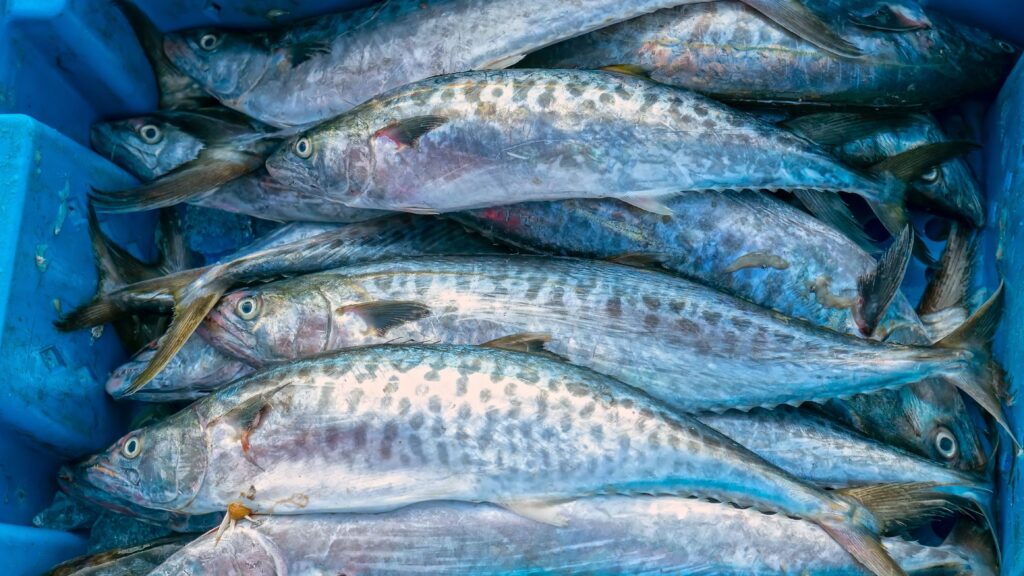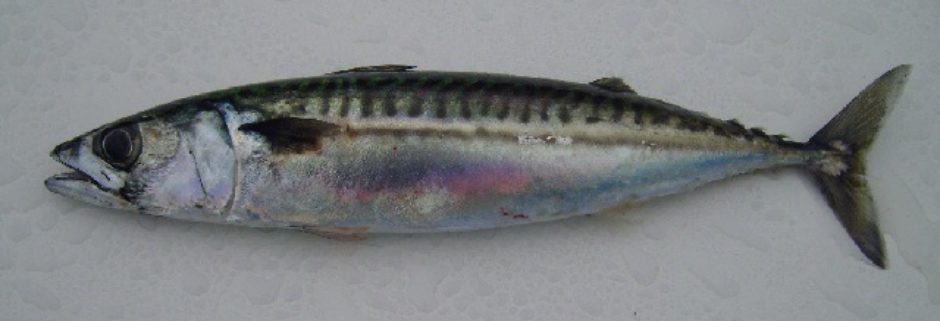
Spanish mackerel are fairly small. Most fish that are caught by anglers will be in the 2 to 3 pound range. These fish travel in schools and they feed on small fish and shrimp.
How to Catch Spanish Mackerel
The most common method of fishing for spanish mackerel would be trolling spoons about a half mile to a few miles off the beaches. Certain beaches do provide some surf fishing opportunities for spanish mackerel, but most anglers have better success fishing from a boat. The piers and bridges can also offer some good fishing for Spanish mackerel when these fish are moving through the area looking for bait fish. Some of the best lures to use are jigs, spoons, crankbaits and swimbaits. Live baits such as finger mullet, small menhaden, pilchards and shrimp work well for Spanish mackerel.
Recommended Tackle
Spanish mackerel aren’t huge, but they can tear through your line in a hurry. Leaders are a must because of their super sharp teeth. Some anglers prefer using wire leaders, especially when using very fast retrieves with artificial lures. Experienced Spanish mackerel anglers will tell you that you are going to get a lot less bites with the wire leaders. Fluorocarbon leaders that range from 25 to 50 pound test line have become common for Spanish mackerel fishing. Because most Spanish mackerel will be in the 2 to 3 pound range, you will most likely only need 8 to 12 pound test line as your main line, which is why the leader is so important. Some anglers will go heavy and use up to 20 pound test line for their main line, but they will still most likely use a fluorocarbon leader that is heavier to avoid bite-offs. Medium to medium heavy action rods are fine for most situations.
Eating Spanish Mackerel
Spanish mackerel have the reputation of having a very fishy taste and not being very good for table fare. However, some anglers do enjoy eating them. The key to eating this fish is to get it on ice right away and cook them the same day that you catch them. If you decide to refrigerate them overnight or put them in the freezer, they will not taste nearly as good as if you would have cooked them the same day that you caught them.
Fishing Inshore for Spanish Mackerel
It’s all timing with Spanish mackerel. Because they travel such great distances at such fast speeds, you may find large schools of them in your area one day and they may be gone the next. When they do migrate into the area that you are fishing, you can usually find Spanish mackerel schooling up and chasing bait fish in open water. Anglers target Spanish mackerel in open water inshore, nearshore and in the surf along the beaches. Some other good areas to fish are off of the piers and bridges. The deeper water around the piers and bridges tend to be more productive for Spanish mackerel. The most experienced anglers will usually look for birds circling and diving down into the water. Feeding birds means bait fish and there’s a good chance that some Spanish mackerel will be around feeding on the bait fish.
To catch these fish, jigs and shiny spoons work great on fast retrieves. Spanish mackerel are very fast and they like to eat fast-moving baits. Live baits such as finger mullet, small menhaden, pilchards and shrimp work well for Spanish mackerel. Most anglers prefer using lures over live bait, especially when these fish are feeding aggressively on bait fish near the surface. Trolling with spoons, jigs and crankbaits are another very effective method for catching Spanish mackerel.
Fishing Offshore for Spanish Mackerel
While most Spanish mackerel are found inshore or nearshore, some anglers do catch these fish offshore as well. Offshore, you can sometimes find Spanish mackerel on the reefs and wrecks. Anglers usually catch them by accident while fishing the reefs and wrecks for other fish like grouper and snapper. In open water, schools of Spanish mackerel can be found feeding on schools of bait fish near the surface. Just like fishing inshore, if you can find the birds circling and diving down into the water feeding on bait fish, there is a chance that Spanish mackerel could also be in the area feeding on those same bait fish.
Trolling for Spanish Mackerel
Trolling for Spanish mackerel is very effective and very common among anglers. Since most Spanish mackerel are found inshore and nearshore running along the beaches, boaters can usually find plenty of fish without having to go far from the shoreline. Along the Gulf coast, the calmer water makes it much easier for anglers to get out and troll for some of these fish with a smaller boat. On the Atlantic coast, it may take a bigger boat to target Spanish mackerel off of the beaches. It all depends on the weather, but the waves will typically be quite larger on the Atlantic coast.
Because most Spanish mackerel are going to weigh just a couple of pounds, fishermen usually like to use lighter tackle when trolling for these fish. Anglers typically use medium action rods with 8 to 12 pound test line and a wire leader or heavy fluorocarbon leader (25 to 50 pound test line) to avoid bite-offs. Planer boards can be used to spread more lines out away from the boat, but it is much more fun catching these fish without planer boards so you can enjoy the fight. Trolling sinkers are usually used with spoons, minnow-shaped crankbaits and jigs as the preferred lures.
Migrating Spanish Mackerel
Spanish Mackerel form very large schools and they travel great distances at very fast speeds. Along the Atlantic coast, Spanish mackerel spend their winters off of Florida. As spring arrives, they move northward up the coast. Spanish mackerel can be found in North Carolina in early April and off the coast of New York in June. During the fall, as waters cool, they return south to Florida waters. In the eastern part of the Gulf, they migrate to the west of Cape San Blas, Florida during the warmer months then they migrate south in the fall. They prefer water temperature in the upper 60s and most charter captains believe that the magic temperature for these fish is 68 degrees.
Best Live or Natural Baits
Finger Mullet
Small Menhaden
Speedos (redtail scad)
Best Fishing Lures
Jigs
Jigging Spoons
Spoons
Crankbaits
Swimbaits
Best Fishing Rigs & Techniques
Best Fishing Rigs
Jigheads
Fish Finder Rig
Shaky Head Jigs
Split Shot Rig
Swimbait Hooks
Weightless Rig
Best Fishing Techniques
Casting
Drifting
Still Fishing
Trolling


